
The North American Rockwell OV-10 Bronco is an American twin-turboprop light attack and observation aircraft. It was developed in the 1960s as a special aircraft for counter-insurgency (COIN) combat, and one of its primary missions was as a forward air control (FAC) aircraft. It can carry up to 3,200 lb (1,450 kg) of external munitions, internal loads such as paratroopers or stretchers, and loiter for three or more hours.
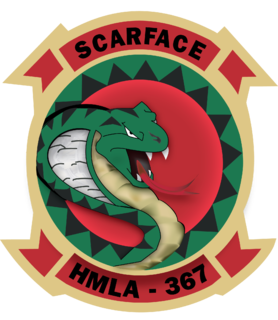
Marine Light Attack Helicopter Squadron 367 (HMLA-367) is a United States Marine Corps helicopter squadron consisting of AH-1Z Viper attack helicopters and UH-1Y Venom utility helicopters. The squadron is based at Marine Corps Base Kaneohe Bay, Hawaii and falls under the command of Marine Aircraft Group 24 (MAG-24) and the 1st Marine Aircraft Wing.

The 1st Marine Aircraft Wing is an aviation unit of the United States Marine Corps that serves as the Aviation Combat Element of the III Marine Expeditionary Force. The wing is headquartered at Camp Foster on the island of Okinawa, Japan. Activated in 1940, the wing has seen heavy combat operations during World War II, the Korean War and the Vietnam War.
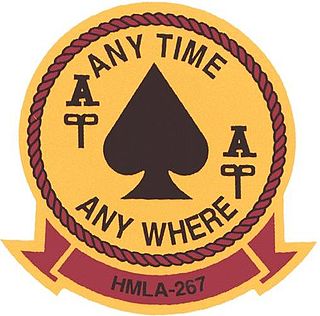
Marine Light Attack Helicopter Squadron 267 (HMLA-267) is a United States Marine Corps helicopter squadron consisting of Bell AH-1Z Viper attack helicopters and Bell UH-1Y Venom utility helicopters. Nicknamed the "Stingers", the squadron is based at Marine Corps Base Camp Pendleton, California and falls under the command of Marine Aircraft Group 39 (MAG-39) and the 3rd Marine Aircraft Wing.
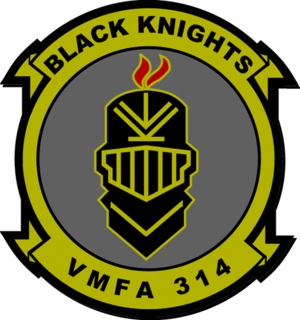
Marine Fighter Attack Squadron 314 (VMFA-314) is a United States Marine Corps F-35C Lightning II squadron. The squadron, known as the "Black Knights", is based at Marine Corps Air Station Miramar, California and falls under the command of Marine Aircraft Group 11 (MAG-11) and the 3rd Marine Aircraft Wing, but deploys with the US Navy's Carrier Air Wing Nine (NG).
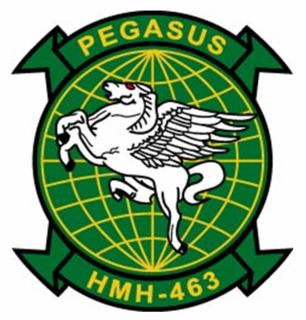
Marine Heavy Helicopter Squadron 463 (HMH-463) is a United States Marine Corps helicopter squadron consisting of CH-53E Super Stallion transport helicopters. The squadron, also known as "Pegasus", is based at Marine Corps Air Station Kaneohe Bay, Hawaii and falls under the command of Marine Aircraft Group 24 (MAG-24) and the 1st Marine Aircraft Wing
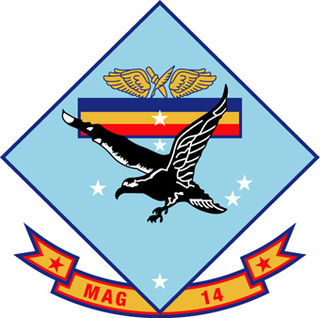
Marine Aircraft Group 14 (MAG-14) is a United States Marine Corps aviation unit based at Marine Corps Air Station Cherry Point, North Carolina that is currently composed of four AV-8B Harrier squadrons, one F-35C squadron, one UAV squadron, one KC-130 squadron, and an aviation logistics squadron.

Marine Aircraft Group 31 (MAG-31) is a United States Marine Corps aviation group based at Marine Corps Air Station Beaufort, South Carolina that is currently composed of two F/A-18C Hornet squadrons, one F/A-18A++ Hornet squadron, two F/A-18D Hornet squadrons, one F-35B Lightning II training squadron, an aviation logistics squadron, and a wing support squadron. It falls under the command of the 2nd Marine Aircraft Wing.
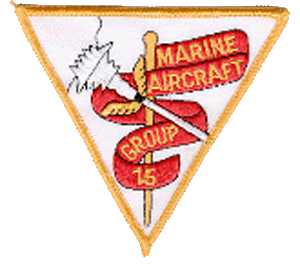
Marine Aircraft Group 15 (MAG-15) was a United States Marine Corps aviation group established during World War II. MAG-15, a transport and photo-reconnaissance training group, was commissioned on 1 March 1942, headquartered at Camp Kearny, San Diego. In addition to radio and photographic training, the Group also conducted a navigation school. Additional roles included West Coast aircraft acceptance and transport service for the Marine Corps.
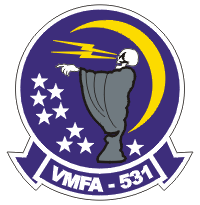
Marine Fighter Attack Squadron 531 (VMFA-531) was a United States Marine Corps fighter squadron consisting of F/A-18 Hornets. Known as the "Grey Ghosts”, the squadron participated in action during World War II and the Vietnam War. They were decommissioned on March 27, 1992.

Marine Fighter Attack Squadron 351 (VMFA-351) was a fighter squadron in the Marine Forces Reserve. The squadron was based at Naval Air Station Atlanta and participated in action during World War II and was decommissioned in 1975.

Marine Observation Squadron 1 (VMO-1) was an observation squadron of the United States Marine Corps which saw extensive action during World War II and supported numerous contingencies during the Cold War. They were based at Marine Corps Air Station New River, North Carolina and saw their final deployment in support of Operation Desert Storm in 1991. They were deactivated on July 31, 1993.
Marine Aircraft Group 93 (MAG-93) was a United States Marine Corps aviation group established during World War II. MAG-93, a dive bombing training group, was commissioned on 1 April 1944 and was initially headquartered at Marine Corps Auxiliary Airfield Bogue, North Carolina. Their mission was to train pilots to fly the Curtiss SB2C Helldiver. The group was decommissioned in October 1945 as part of the post-war drawdown of forces and has been inactive since.

Marine Aviation and Training Support Group 33 (MATSG-33) is a United States Marine Corps aviation training group that was originally established during World War II as Marine Aircraft Group 33 (MAG-33). Fighter squadrons from MAG-33 fought most notably during the Battle of Okinawa and also as the first Marine aviation units to support the Korean War when they arrived as part of the 1st Provisional Marine Brigade. They helped stabilize the United Nations positions during the Battle of Pusan Perimeter and fought in Korea for the remainder of the war. At some point in the 1960s, the group was deactivated and was not reactivated until 2000, when Marine Aviation Training Support Group at Naval Air Station Oceana, Virginia was renamed MATSG-33.

Marine Torpedo Bombing Squadron 151 (VMTB-151) was a dive bombing squadron in the United States Marine Corps. The squadron fought in World War II but was quickly deactivated after the war on March 20, 1946.
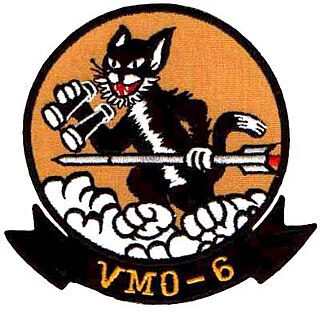
Marine Observation Squadron 6 (VMO-6) was an observation squadron of the United States Marine Corps which saw extensive action during the Battle of Okinawa in World War II and the Korean War and Vietnam War. The squadron would become the first Marine Corps helicopter squadron to participate in combat operations when they participated in the Battle of Pusan Perimeter in August 1950. They were deactivated on January 1, 1977.

Marine Fighting Squadron 511 (VMF-511) was a fighter squadron of the Marine Corps and Marine Forces Reserve during World War II and the Cold War which flew aircraft types such as the F6F Hellcat, F4U Corsair, and the F-8 Crusader. They were originally activated during World War II and fought during the Battle of Okinawa and the Battle of Balikpapan (1945). They specialized in close air support and during the course of the war were credited with only one plane shot down.

Marble Mountain Air Facility (MMAF), also known as Da Nang East Airfield, Marble Mountain Army Airfield and Nuoc Man Airfield, was an aviation facility used primarily by the United States Marine Corps during the Vietnam War. It was a helicopter facility that was constructed in August 1965 and served as home to Marine Aircraft Group 16 (MAG-16), the 5th Special Forces Group and an assortment of other squadrons until May 1971. It was controlled by the United States Army from May 1971 to August 1972 and finally by the Republic of Vietnam Air Force (RVNAF) from 29 August 1972 to 29 March 1975 when it fell to the People's Army of Vietnam (PAVN). It was in Quảng Nam Province 5 miles (8 km) southeast of Da Nang Air Base on a strip of beach between China Beach and the Marble Mountains.
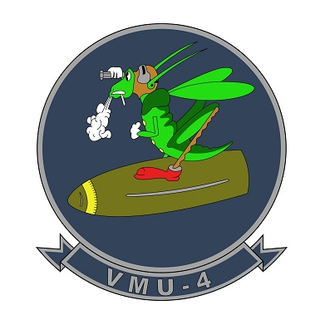
Marine Unmanned Aerial Vehicle Squadron 4 (VMU-4) is an unmanned aerial vehicle (UAV) squadron in the United States Marine Corps that operates the RQ-21 Blackjack. It is the fourth UAV squadron in the Marine Corps and the first in the reserve component. The squadron, nicknamed the "Evil Eyes", entered the force structure on 1 July 2010, when Marine Observation Squadron 4 (VMO-4) was reactivated and redesignated VMU-4.






















